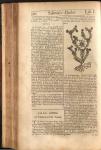This chapter hasn't been proofread yet.
I. The Names, k is called in Greek, Tv^dhtov: J. in Latin, Gnaphalium, Centunculus, Cen-tuncularis, Tome nt urn ^Foment aria, Foment itia, Cotto-nana, Bombax humilfs, Albinuw, Chamxxylon F/inii and Yilago: in Englishj, Cudweed or Cottonweed.
II. The Kinds. There are four principal sorts of Cudweed, I. The Common, of which in this Chapter. 2. Gnaphalium Impium, Wicked Cudweed, of which in Chap. 181. 3. Gnaphalium Marinum, Jive Cottonaria, Sea Cudweed or Cottonweed, of which in Chap. 182. 4. Gnaphalium Amcricanum, Ancricarr Cudweed, of which in Chap. 183.
III. Of the Common kind there are, 1. Gnaphalium vulgare maim Johannis Thalii, Gnaphalium Anglicurn folio longiore Lobelii, English Cudweed, 2. Gnaphalium minus, Yilago minor, Dodonti, Gnaphalium vulgare minus, Gnaphalium medium Tabern-montani, The Vulgar or Common lesser Cudweed.
from whence rise up one, two or three Stalks, set thick on all sides with long and narrow whit φ or woolly Leaves, almost from the bottom of the Stalk, up to the top: with every Leaf (lands a small flower, of a dun or brownifb yellow color, but not so yellow as in some others in which Heads, after the Flozv-ers are fallen, come small Seed, enchfed in the Down, and which, when perfected, is carried away with the Wind.
IV. The Descriptions. The first, or English Cudweed, hcts a Root which is small and thready;
V. The second, or Lesser Cudweed, has a fibrous Root, almost like the former* _·, from whence shoots forth small hoary Stalks, full of Branches almost from the very Ground, with divers fmalkr, fiwrter and narrower Leaves thereon, of a more dusky hoary color, like fine Cotton or Wcoll $ some standing singly, and some more at a Space or Joint: the Flowers hereof stand at the tops of the Stalks and Branches only, and not all along, a* in some of the other kinds, one Branch above another, but all of them rising almost to an even height, ami are of an overworn yellow color: it grows commonly about nine or ten inches high, seldom to d foot, unless in choice Ground. The Flowers are ye/low, and grow like Buttons at the tops of the Stalks, and the Seed is carried away with the Wind.
VI. The F laces. They both grow in barren, dry, fandy and gravelly Grounds in most places of England : the first has been found growing in Hamp-ficad Wood, and in Woods near to Deptford, by London.
VII. The Times. They flower in June, July and Augufl ^ and their Seed is ripe in a little time after.
VIII. The Qualities. They are temperate in respect of Heat or Cold, but dry in the third Degree ^ and therefore very Astringent, Hepatick, and withal Anodyne.
IX. The Specification. They are peculiar against Catarrhs, Fluxes of the Bowels, Profusions of Blood in any Part, and the (^infey,
X. The Preparations. You may have therefrom, ι. A liquid Juice. 2. An Essence. A Decoiction in Wine. 4. A Pouder. 5. A Cataplasm.
The Virtues.
XI. The liquid Juice. Taken inwardly to an ounce or more, mixed with a Glass of Red Port Wine, or in some other proper Vehicle, it Hops any inward Bleeding : it cleanses old and filthy Ulcers, and causes them quickly to heal. Taken in Wine, or in Milk, it is (as Pliny says) a soveraign Remedy against Heat and Swellings in the Throat, and that which is vulgarly called the Quinsey : and he farther says, That whosoever shall take it shall never be troubled with that Disease again. And for the same Reason Country People give it to their Swine, with this Observation, That whichfoever of them will not take it, will alluredly die.
XII. T/v Essence. It has the Virtues of the liquid Juice, but more powerful _·, and over and above in the curing of old running Sores and Ulcers, it is of admirable Excellency. It stops and cures all Fluxes of the Bowels, tho' of long standing, and restores their Tone again to Admiration. It cures the Whites in Women, as also the overflowing of their Terms, is singular against rebellious Catarrhs, and discusses simple Contusions _·, kills Worms in Children, and heals Ruptures.
XIII. The Decoction in Wine. It has the Virtues of the Juice and Essence, but in a lower degree, and may be given from 4 to 6 or 8 ounces, according to Age j 1. In the Morning falling. 2. Half an hour before Dinner. 3. At Night going to Bed. Possibly this may be best for weak Stomachs.
XIV. The Pouder. It drys, binds and astringes, and therefore is profitable for Defluxions of Rheum from the Head upon the Lungs, as also to stop Fluxes of Blood wheresoever. Taken from 1 to 2 drams in Red Port Wine, it prevails against the Bloody-flux, and eases the Tortions of the Bowels coming thereby : it stops the overflowing of the Terms, and heals Wounds whether inward or outward, being made into an Electuary with the liquid Juice, and lb used. This Pouder being either drunk or injected up the Inteftinum Reifum, mixed with Red Port, cures the Disease called Tenesmus, which is an often Provocation of going to Stool and doing nothing.
XV. The Cataplasm. It may be made either of the green Leaves bruised with a small quantity of Wine, or else of the Pouder of the Herb made into the Consistence of a Cataplasm with the liquid Juice. Being applied, it immediately stops the Bleeding of Wounds, and in a short time afterwards cures them: it also cleanses, drys and heals all old and filthy Ulcers.

 Page 295
Page 295 Page 296
Page 296